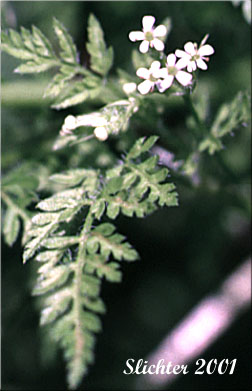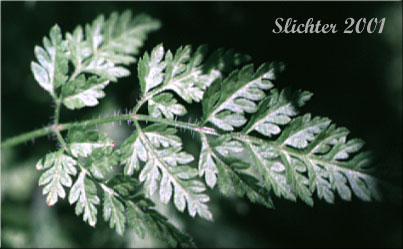 The
photo at right is of chervil from Horsethief Butte in the Columbia River Gorge..........May
5, 2001.
The
photo at right is of chervil from Horsethief Butte in the Columbia River Gorge..........May
5, 2001.Chervil is a weedy species of european origin with erect branching stems (slender to stout) from 40-90 cm high. The stems are generally smooth or hairless while the leaves have some spreading hairs. The basal and stem leaves are pinnately compound with many small segments. The leaves are reduced upwards on the stems.
The inflorescence is a several rayed compound umbel. The small umbels are 3-7 flowered, each flower with a short pedicel. The fruit is ovoid and about 4 mm long. The fruit are also covered with numerous short, unarmed prickles. Chervil is an annual. It was brought to the United States as a garden herb, being prized as a salad plant. The plant self-seeds readily and has thus escaped cultivation to become established in feral places.
Chervil may be found in moist open places or in disturbed soils such as those found along roads or trails, or may be found around old farm buildings. It is especially common and dense beneath trees and shrubs in places that have been grazed or suffered other disturbances.
Chervil is a native of Europe which has been introduced to the eastern United States and also on the west coast from Washington to California.
